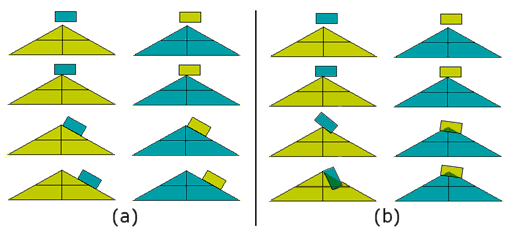Contact penetration types
Although no penetration is permissible with any of the contact types, when defining a manual contact you can set the Penetration Type to Symmetric or Unsymmetric. Symmetric is the default setting and prevents interference between two parts. In other words, penetration of one body by the other cannot occur. However, it is the most time-consuming option to solve.
With the Unsymmetric penetration type, loads are allowed to cause interference between parts, meaning that it is possible for one body to penetrate the other. This is a good option to save solution time for well-mated contact surfaces, when both faces are flat or have the same curvature, and the applied loads do not cause interference. When appropriate, Unsymmetric contact makes the solving phase more efficient, but do NOT use this option unless you are absolutely sure that loads will not cause interference.
In each contact set, one body is designated as the Primary Body, and the other the Secondary Body. The distinction between Primary and Secondary is important when you choose the Unsymmetric Penetration Type, as described below.
Penetration Type
Symmetric:
This setting is the default Penetration Type. Contact is detected and enforced for either of the following two conditions:
- A node on the Secondary Body contacts the face of an element on the Primary Body.
- A node on the Primary Body contacts the face of an element on the Secondary Body.
Unsymmetric:
Contact is only detected when a node on the Secondary Body contacts an element face on the Primary Body.
Penetration Type behavior
In the following image, a small rectangular body with only one mesh element is falling, by gravity, onto a larger triangular body that has a relatively coarse mesh consisting of four elements. Light blue designates the Primary Body, and yellow designates the Secondary Body.

Figure 1: showing penetration, where (a) represents Symmetric contact behaviour and (b) represents Unsymmetric contact behavior.
In the group (a) images, which demonstrate Symmetric contact behavior, no penetration occurs into either the rectangle or the triangle. Regardless of which part is the primary body and which is the secondary body, the block slides down the inclined surface of the triangular part.
In the group (b) images, which demonstrate Unsymmetric contact behavior, penetration occurs into both the rectangle and the triangle, depending on which body is the primary body and which is the secondary body. :
- When the rectangle is the primary body, the nodes on the secondary body (triangle) cannot penetrate it. However, the primary nodes can penetrate the secondary faces. Therefore, the primary body passes through the secondary body because the mesh is too coarse to prevent it from happening.
- When the triangle is the primary body, its nodes can penetrate the faces of the rectangle (secondary body). Motion stops when the secondary body nodes contact the primary body faces, and penetration is prevented. Therefore, the rectangle gets stuck. It cannot penetrate any further, and it cannot slide down the inclined surface of the triangle.
